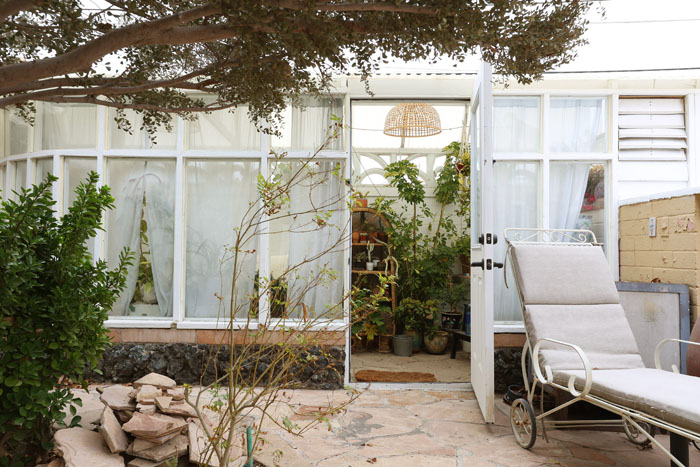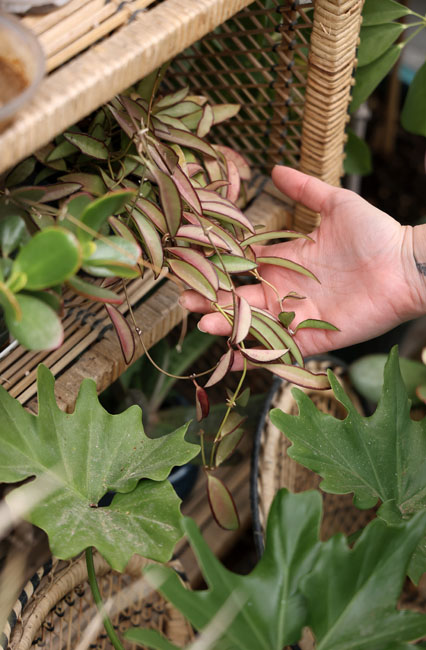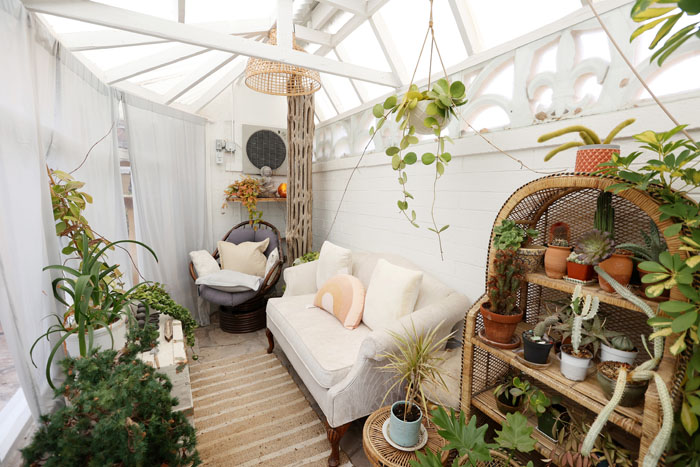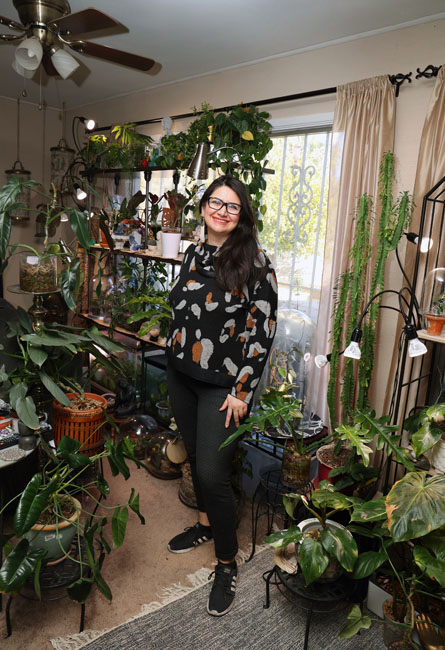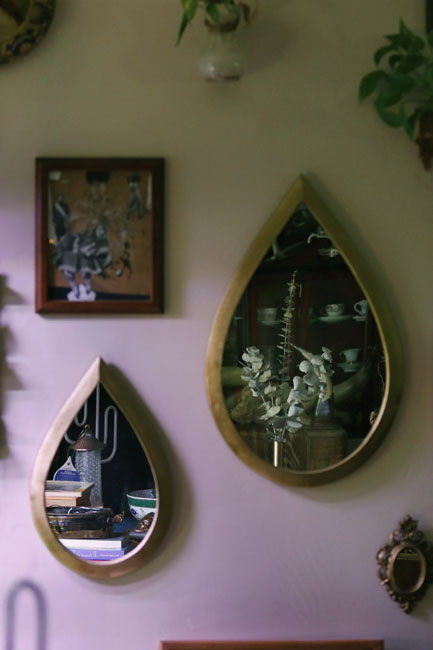Nanda Sharif-pour discusses her use of living plants, soil, and video in her work from her Las Vegas, Nevada greenhouse.
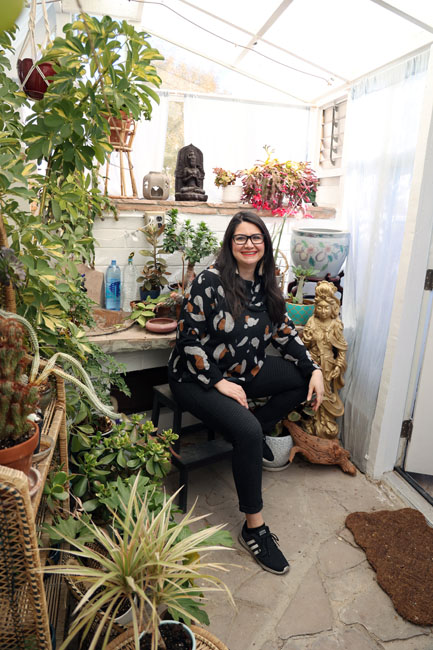
“Both of my grandmothers had green thumbs,” Nanda Sharif-pour says. This is unsurprising, as Sharif-pour is constantly surrounded by verdant life. Her home is resplendent, full of potted plants, and her backyard greenery and fruit trees surround a wall of Bodhisattvas.
Using living plants, soil, and video in her work, Sharif-pour asks viewers to consider the precarity of our relationship with space through the living environment. “[Plants] have been on the face of the earth for millions of years, have survived all these changes,” she says. “Now we look at them through a very tiny portion of time.”
Like much of her indoor and outdoor greenery, Sharif-pour is a transplant, uprooted and adapted to new environments. She and her husband, artist Ali Fathollahi, are refugees from Iran.
Growing up in Iran, Sharif-pour was encouraged to find something “practical,” so she pursued both a bachelor’s and master’s in graphic design and illustration in Tehran.
Now earning her living as an artist and university instructor in Las Vegas, Nevada, Sharif-pour has finally felt a sense of stability that has allowed for further exploration in her work and the pursuit of a second master’s degree at the University of Nevada, Las Vegas.
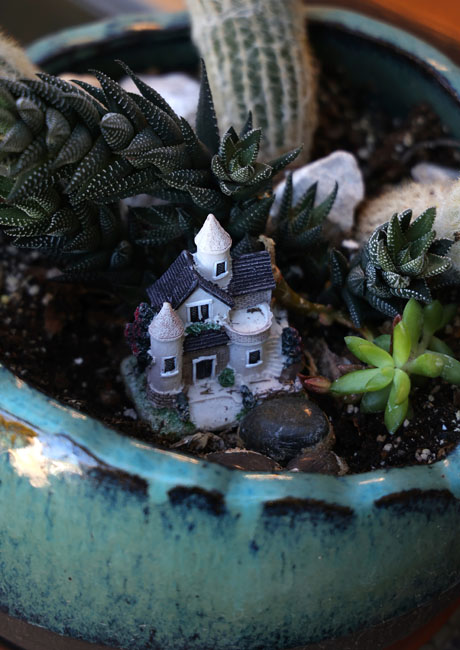
While in graduate school, land became an important part of her practice. Moving from Iran as a refugee to Turkey and then to Las Vegas, “the memory of the land I was living in and born in, changing it, finding a new home, it all became something more than geographical space.” Her 2019 thesis work Implanted Nature involved projected videos of greenery among giant heaps of soil filling a gallery.
For Sharif-pour, her installations materially demonstrate the effects of migration on the body in a way painting cannot physically access. “I like working with the physical volume that [installations] occupy and the way [the audience] has to interact with it,” she says.
The politics of Sharif-pour’s work are not always loud, but are always present. The installation ONE (2020) projected the poem “Bani Adam” (“Children of Adam”) by medieval Persian poet Saadi Shirazi onto an apartment building in downtown Las Vegas. All human beings are members of one frame / since all, at first, from the same essence came, it declares. Though the installation was made in response to U.S. governmental tensions with her home country, in light of Iran’s recent political uprisings and violent government suppression, this work effectively substitutes poetry for violent images.
Much of her recent work involves bringing the surrounding desert landscape into the gallery—a climate-controlled, sterile, and supposedly “neutral” environment. For instance, she brought the desert indoors via a small terrarium at the rural Bullfrog Biennial in Beatty, Nevada. The Mojave Desert is very different from the deserts of Western Asia, and vastly different from the verdant mountains of her youth in Tehran. But Sharif-pour has worked to create her own sense of space amid drought-stricken land.
In Cereus Repandus aka Peruvian Apple Cactus at The Barrick Museum (2022), a cactus in a dirt-filled wheelbarrow sits in the middle of the museum floor. The cactus—bodily standing about the height of a person—originated in South America and traveled to the U.S. to end up in an art gallery. The work references “immigrants in a transitory phase, until they find a final destination to feel grounded and keep growing,” she says. “Only then can they pick up where they left off.”
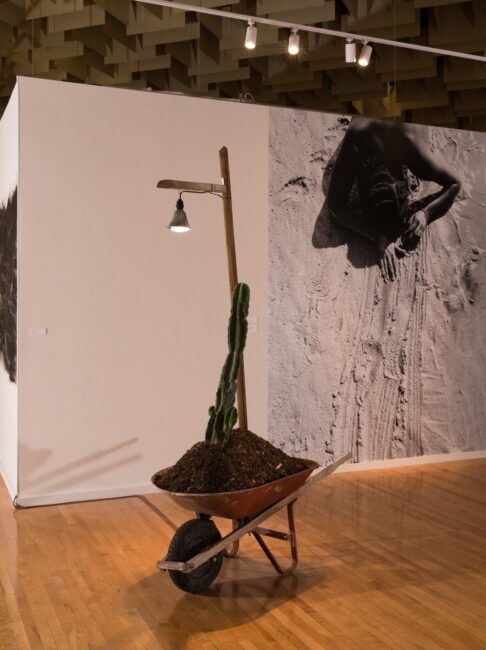
Next to the cactus sits a plastic gallon jug of water, connected by a long strip of fabric, slowly transporting water into the soil—reminiscent of the water jugs left for migrants in the Sonoran Desert that are often destroyed by American border police, denying the precious resource to vulnerable people on a dangerous journey.
The jug, the wheelbarrow, and the plug-in lamp only provide the bare minimum nutrients for the plant to survive. The bare minimum is not enough to grow; the plant is inhibited by its transitory nature. Though it is resilient and adapts to change, it becomes damaged in the process of transition.
In a recent work at the Barrick Museum’s outdoor window gallery, Sharif-pour installed a video that plays a live stream of a security camera pointed at a branch only a few feet away. The branch in Meanwhile, a few feet away from you (2022) will continue to exist and grow without our eyes on it, and does not exist to be watched. “We don’t pay attention to it until it is on the screen and selected for us to watch,” she says. Even in the present moment, looking at the work, the viewer is not actually looking at the plant, but an image of the plant mediated through a camera and a screen, with pixelations, glitches, and delays.
Climate catastrophe and human impacts on the environment have immediate effects, and are often felt most acutely by vulnerable populations like impoverished people, the Global South, and migrants. Plants comprise about 80 percent of the world’s biomass, the entire collected weight of all living matter on the planet. Humans account for less than one-tenth of a percent. Sharif-pour’s work is not asking us to pity the natural world, but to pay attention to it—and see ourselves in it.
